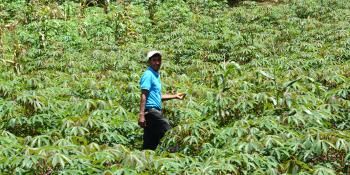Planning national adaptation responses to climate change

Summary
Climate change research must be nationally relevant for research outputs to be used broadly. This is why CIMMYT-CCAFS conducted its research in close collaboration with the Ethiopian Institute of Agricultural Research (EIAR) and other stakeholders in Ethiopia. The climate research outputs generated were used as inputs during the development of Ethiopia’s National Climate Change Adaptation Strategy. The collaboration with national stakeholders also helped in building national climate research capacity in Ethiopia where climate change information is limited.
Background
Ethiopia is highly vulnerable to climate change due to its low level of economic and social development, low levels of income per capita, limited disaster risk management and weak institutional capacities. The agricultural production systems in the country mainly depend on rainfed agriculture which is sensitive to the negative impacts of climate variability and change. Agriculture is of particular concern in Ethiopia not only because the sector is most vulnerable to climate change but also because it is practiced by smallholder farmers who have poor starting conditions, weak adaptability, and limited adaptation options (NMSA 2007). A large proportion of the population (>80%) of Ethiopia is employed in the agricultural sector which is mainly based on human and animal energy.
Read the full outcome study for more information on the background.
Scope and methods
This study aims at evaluating and tracing evidence on CIMMYT-CCAFS research which informed the Ethiopian Government’s Climate Change Adaptation Strategy (CCAS) and other climate change initiatives in the country at different levels. CIMMYT-CCAFS research focused on developing adaptation interventions to improve the resilience of crops to climate variability and change in general and more specifically of the maize and wheat cropping systems through generation of scientific knowledge and information on agriculture-relevant climate-induced risks.
The methodologies used include gathering information through key informants such as interviews with experts at relevant government ministries, research and academic institutions, and review of reports. The major ones include:
Interviews with high-level experts from the Ministry of Agriculture and the Ministry of Environment and Forestry on climate change policy and strategy issues.
Interviews with CIMMYT-CCAFS researchers and research managers at EIAR.
Discussions with regional policy makers and research staff of relevant regional research centres particularly those involved in maize and wheat research in Oromia regional state, and higher learning institutes (e.g. Haramaya University).
Review of relevant documents which include
Ethiopian Climate Resilient Green Economy (CRGE) strategies developed by the Government of Ethiopia: Phase 1 (climate change mitigation) and Phase 2 (climate change adaptation)
Key findings
EIAR-CIMMYT-CCAFS provided continuous input to the development of the National Climate Adaptation Strategy. EIAR-CIMMYT-CCAFS scientists were part of the consultative meetings and workshops held on strategy development and provided feedback on the draft document.
The output of the EIAR-CIMMYT-CCAFS research indicated that extreme weather has a major impact on the Ethiopian economy and recommended to prioritize this in the Strategy.
The Climate Resilient Green Economy Unit (CRGEU) in charge of the mitigation and adaptation activities at MoA, was able to broaden their knowledge base through active participation in climate change meetings, workshops and briefings organized by EIAR.
The Extension Directorate of MoA collaborated with EIAR/BGAD to forecast the 2014/2015 rainfall season and developed a strategy for regional governments to take precautionary measures incorporating the drought frequency indices developed by CIMMYT-CCAFS.
The findings of EIAR-CIMMYT-CCAFS climate researchers were incorporated in the seasonal climate outlook strategy which was used to develop crop management practices.
Regional governments are using the findings of EIAR-CIMMYT-CCAFS to incorporate in their regional climate change policy and adaptation strategies.
NGOs are keen participants of EIAR-CIMMYT- CCAFS climate change workshop and are now putting more emphasis on climate and environmental issues in their interventions.
Conclusions
Ethiopia is a land of diversity and opportunity. The country has many different agro-ecologies and farming systems that vary within short distances. Therefore the government needs site-specific research results to plan and develop sustainable agricultural production at the smallest administrative units. EIAR-CIMMYT-CCAFS conducted research to analyse past and future climate risks in almost all agro-ecologies but with a focus on the wheat- and maize-based production systems of Ethiopia.
The study is timely and relevant and in line with the government’s objective of minimizing the negative impacts of climate change and enhancing agricultural production on a sustainable basis. The government wants to know what needs to happen to agriculture, and related land use and water management under climate change in order to design appropriate mitigation measures.
Recommendation
The EIAR-CIMMYT-CCAFS partnership is a good example of how collaboration at the national/local level builds capacity and generates research outputs that influence national and regional policy and action. EIAR-CIMMYT-CCAFS researchers are drafting articles for journal publication. However, preparing policy briefs and organizing policy workshops would be advisable in order to utilize the full potential of the research outputs.


